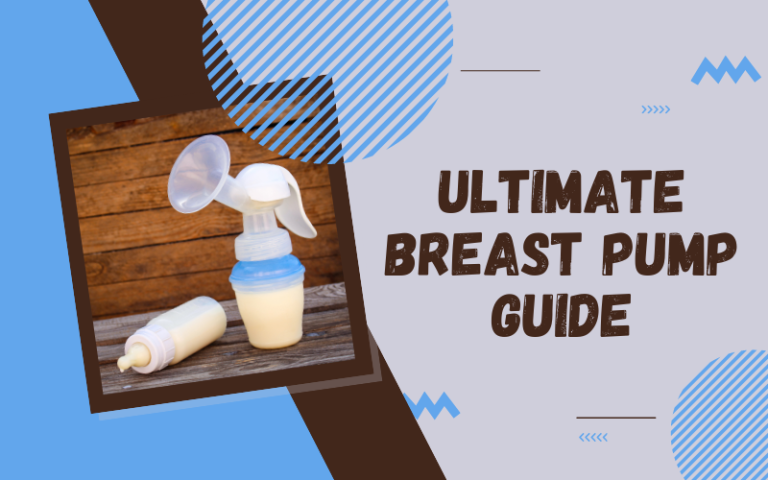Welcome to BMOTG ultimate breast pump guide!
Click here to read our guide on the double electric pumps or click here to read our guide on how to choose a breast pump for your needs.
BMOTG Ultimate Breast Pump Guide for Mums
Whether you’re expecting your first little one, or you’re a mother who’s yet to express milk, you need to know a little bit about breast pumps and how they work.
This is what you should know before buying a breast pump or researching and reading breast pump reviews.
While there are several different varieties of breast pumps available, we’ll explain the basics of how they all work first.
How Breast Pumps Work
A breast pump in its basic form is essentially a device with 3 main parts: a shield that covers your breast, the motor which generates the suction and a bottle that collects the milk.
The breast shield is the part that covers the breast and many breast pumps will have two of these shields (one for each breast). These are known as Double Breast Pumps.
The motor is responsible for generating the suction that allows the milk to travel from the shield to the bottle.
This will either be an electric motor; found in an Electric Breast Pump or a hand pump; found in a Manual Breast Pump.
Breast Milk vs. Formula
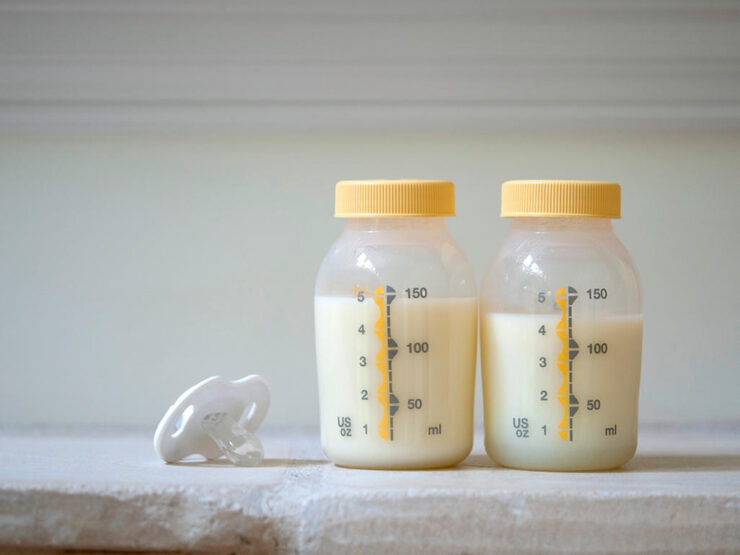
Research carried extensively across hospitals and healthcare centers over the years, has conclusively established the superiority of mother’s breastmilk over formula milk.
Breast milk is now considered to be the best gift that any parent can give to her new-born child.
Studies carried out between groups of breast-fed infants and bottle-fed infants consistently show that the former are less susceptible to be admitted to the hospital for health reasons.
They are more resistant to diseases such as pneumonia, botulism, bronchitis, staphylococcal infections, influenza, diarrhea, rashes, German measles and a host of allergies, as compared to bottle-fed infants.
The infant mortality rate has also been perceived to be higher in bottle-fed infants.
The Food and Drug Administration has come out with stringent regulation procedures for commercially prepared formulas.
The manufacturer of formula milk is required to analyze each batch of the product that comes from the factory floor for the required nutrients.
All containers are coded for easy batch identification. During the shelf-life of the product, samples are tested randomly for its stability by health officers.
Though formula milk tries its best to imitate breast milk, it is still a close second. What makes breast milk so superior?
The reason is still a mystery.
Human milk is very complex, and not much, beyond mundane chemical composition, has become known about it.
Fat forms a major source of calories in breast milk, which is logically justified, since infants require a lot of energy for those cells to grow rapidly and multiply; and they have no other food to source from.
Other ingredients include living cells, hormones, active enzymes, immunoglobins and compounds with quite unique structures.
About eighty percent of the cells in breast milk are disease-resistant antibodies and macrophages. These antibodies are dynamically generated inside the mother’s body, in response to whatever disease is present in the environment of the mother and the child.
Thus, whenever the child is nursing or feeding on expressed milk, it is getting food that is customized for its immediate surroundings. This is a feature that no formula milk can ever beat!
There are a few situations, however, when breast milk is not advised, and formula milk is the only way out.
Mothers suffering from HIV-positive AIDS, herpes, hepatitis, and beta streptococcus infections can transmit these diseases through their breast milk.
Mothers with silicone breast implants risk leaky implants to harm the baby; with some studies reporting a link between silicone and esophagus problems of children.
In cases where infants are not able to be breastfed, it is recommended to go in for cow’s milk-based formula.
However, lactose intolerance in the child should be continuously monitored. Adverse reactions to cow’s milk could include excessive gas, abdominal distension and pain, and diarrhea.
An alternative in such a situation is to start with soy formula, which though not as protein-rich as cow’s milk, has abundant carbohydrates such as sucrose and corn syrup.
These can be easily digested and absorbed by infants. The calcium present in the formula, besides other minerals, doesn’t get absorbed by the child, however.
The third alternative formula milk is hydrolyzed proteins.
This milk is made from cow’s milk, with additional processing that breaks complex protein molecules into its component parts, making it predigested, and thus making it easier on the child’s inner stomach linings, besides reducing any risks of allergy.
Iron-fortification of formula milk – to the extent of about twelve milligrams of iron per liter – is carried out by quite a few formula milk manufacturers.
However, there is another set of formulas available with low iron too, where the iron content is about two milligrams per liter.
Such groupings exist to cater to children with either type of requirement.
Again, studies have established that infants absorb virtually one hundred percent of iron from human milk, but considerably less from infant formula. So, breast milk is a winner, every step of the way!
Manual Expression – Pros and Cons
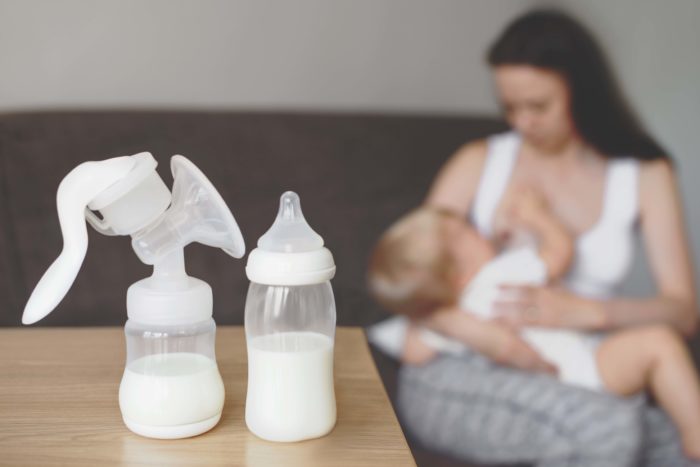
Breastfeeding one’s child is the best gift that a mother can give to her precious bundle of joy.
The milk coming from the mother not only feeds the child’s hunger on the spot but also builds up antibodies and nutrients in the child’s body that prepare it to face the rigors of life in the years to come.
The complex and still mysterious constituents of nature’s best food act as a shield against the germs and diseases permeating in the air, not only when the child is at its most vulnerable, but also when the child grows into an adult.
No wonder, then, that healthy mother’s milk is now preferred any time over formula milk.
To the extent, that, working moms would gladly trade in – as much as their circumstances permit – their productive hours for a few quiet moments expressing their milk to be fed to the child.
It is not uncommon to find mothers beautifully balancing the demands of work with the nutrition and care needs of the child.
Breastpumps – one of the most practical inventions for both the working mother and those who face special breastfeeding conditions – is a handy tool that enables the mother to overcome any guilt feelings of having to be away from the child when the latter needs her the most!
The breast pump has become such an integral part of the post-natal kit over the past two to three generations, that it is now unthinkable for mothers, who cannot directly breastfeed their child, to be able to do without it.
There are times, however, when manually expressing milk is a better, or the only option available.
And, – surprise! – there is no cost associated with this technique. The basic first activity that one has to do upfront, is to find a quiet place where one can relax, and prepare oneself physically and mentally so that the flow of milk is automatic and smooth.
When the breasts appear to be full and soft, cup one breast in the hand, with the thumb above and just slightly behind the areola.
The other fingers may be pressed against the tissue below the nipple. Push the breast back, and squeeze the thumb and fingers together.
When the fingers are rolled forward, pressure starts shifting from the back of the breast towards the nipple.
This stimulates the milk ducts to release milk through the nipple. Feel your breasts all the time: you can, with consistent practice, even identify the particular duct where milk is still available, and apply suitable pressure on the exact spot such that milk is drained out.
This sequence is to be repeated on both breasts, after working on one breast for about three to five minutes.
The milk thus produced can be stored in just the same way as when a breast pump is used.
When is manual expression advantageous? Well, the primary reason that can be cited these days, is when the regular breast pump is facing some problem.
Also, manual expression gives mothers absolute control over the speed and comfort with which they can produce milk.
They can, as described above, actually feel the ducts where pressure needs to be applied to generate milk.
Since the exercise involves no automation, the mother knows exactly when to stop expressing.
A breast pump, on the other hand, works in its own pre-programmed way – with a rhythmic suck-and-release mechanism that is unmindful of the breasts’ actual condition.
When is manual expression actually harmful, or not workable? The immediate reason that comes forth is when the breasts are engorged.
In situations when milk has not been expressed for a longer period of time than usual, milk starts getting accumulated in the ducts, and not finding an outlet, swells the ducts and the surrounding tissues.
In extreme cases, the hardening of the breast around the areola may take place, which is known as “engorgement”. In such a situation, touching the breasts by one’s hand might be quite painful.
Deploying hospital-grade pumps in such circumstances is a good remedy in such cases. The market is full of models that address this very condition quite remarkably.
Another reason when manual expression might not work is when the nipples are flat or inverted.
Usually, there are tissues beneath the skin that pull the nipples back or restrain them, such that manual expression is hindered. A breast pump, again, comes in handy in such a circumstance.
It is the mother’s judgment and wisdom to decide when and where to go in for manual expression, and when to deploy a breast pump.
After all, who knows the child better than its mom?
The Difference Between Electric and Manual Breast Pumps
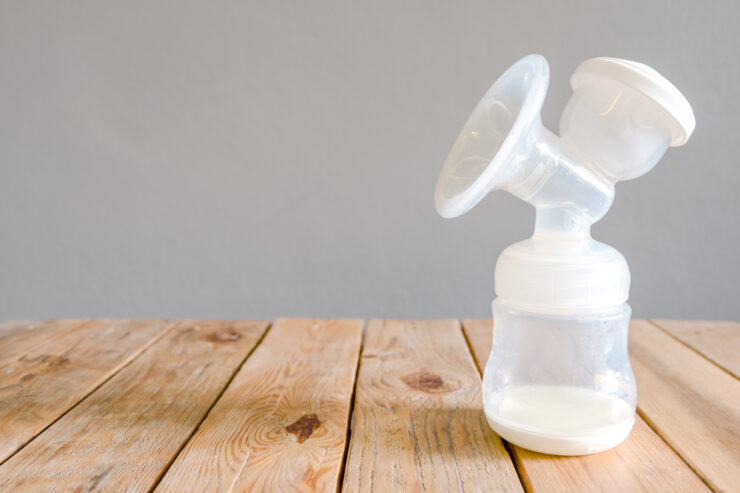
After reading through some of the breast pump reviews available on the internet you’ll generally find that most mothers prefer the use of an electric pump as manual breast pumps tend to be both tricky to get the hang of and time-consuming.
Electric pumps will generally come with a control panel where the level of suction can be increased or decreased to your liking.
A higher suction level will yield more milk but can be uncomfortable so it’s a matter of finding the right balance between comfort and convenience.
Many electric breast pumps also have a special let-down cycle or phase which helps get the milk flowing by mimicking a baby’s natural feeding pattern.
When researching and going through breast pump reviews this can be a very handy feature to look out for.
Depending on the type of pump; Double Breast Pump or Manual Breast Pump, the device will come with 1 or 2 bottles to collect the milk.
These bottles will generally come with baby bottle lids with nipples that can be attached to feed the little one.
The Ritual Cleaning of Breast Pumps
Breast Pumps require regular cleaning and sterilization and it’s generally recommended they be cleaned before each use.
Fortunately, most breast pumps on the market are relatively easy to disassemble, with all the separate parts coming apart quite easily.
Depending on the brand and how the parts are manufactured you may need to hand wash them in warm soapy water before drying.
However, many breast pump parts can either be boiled or placed in a dishwasher for convenient washing and sterilization.
While there are a plethora of information and breast pump reviews out there to peruse, we hope this guide gives you a good basis to work from.
Second-hand or Used Breastpumps
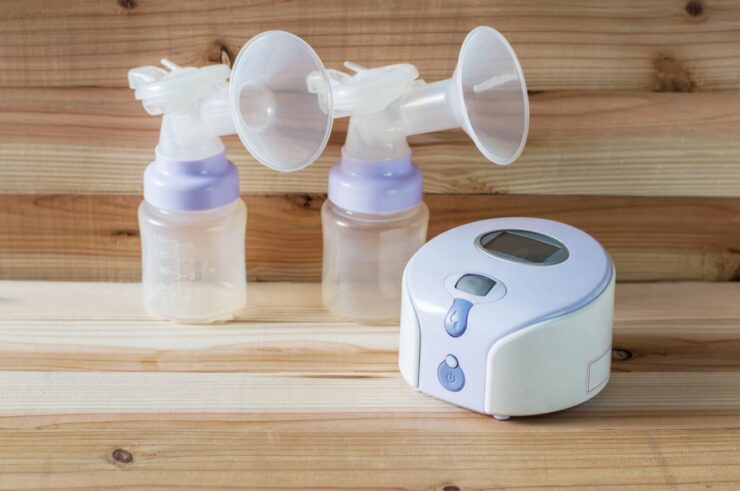
Man’s (and woman’s) natural proclivity is towards getting a better deal in any commercial transaction.
We tend to go for the best that is available at as cheap a price as possible.
Sometimes, mothers in the family or friend circle happily lend their used breast pumps to an expectant mother, without thinking twice.
The latter, too, accept it gladly, partly because it reduces the already ballooning pregnancy cost, and partly because they consider the lender to be an expert, and more knowledgeable in such matters.
This scenario works out quite frequently in homes throughout the country.
It is not surprising, for there is a huge business of rental pumps out there in the market. So, using/sharing used pumps are taken for granted.
There are pumps and then there are pumps.
The subtle difference that companies make, when they come out with pumps-for-sale and pumps-for-rent, is that, with the latter, the collection kits are designed in such a way that the milk never touches those parts of the pump that a mother handles directly.
The collection kit, comprising of bottles and the tubing is always given from the fresh stock at the time of renting out a pump. Pumps for rent are usually also called “closed systems”.
In contrast, pumps-for-sale are designed in such a way that the components that touch the human body open to or come in direct contact with, the collection kit’s tubing.
Even the motor’s diaphragm may be open to the tubing in some cases.
This increases the possibility of milk particles from the breast shield dripping over the diaphragm and getting collected thereabout.
These diaphragms cannot be removed or sterilized, unfortunately, at the consumer level.
When this pump is handed over, with all good intentions, the new mother receives the hidden milk in the bargain, too.
The result is that milk from another mother can get mixed with the new mother’s milk, even when the bottles, tubings, and breast shields are new.
This activity may happen invisibly, without the mother becoming aware of it.
Now the problem with such milk is the possibility of it containing viruses or germs that the new mother and her baby have not already developed immunity to.
This plainly implies that the risk of being infected by this virus increases. Potential candidates in this category include HIV, Hepatitis B & C, and the like.
This issue is serious enough for quite a few reputed companies to declare in bold type their cautionary message on their website.
The FDA has, in fact, quite a few paragraphs devoted to the issue of using previously owned breast pumps, on their official website.
The aging of used breast pumps
Used breast pumps also have one feature that mothers do not realize immediately. This is the matter of the aging of breast pumps.
All devices have a definite age, beyond which they simply refuse to function. Rarely does a pump come with a warranty that extends for more than a year?
So, if the mother has borrowed a used device from somebody she knows, and if the device stops working, she might have to contend with the conscience of providing the lender with a replacement.
This really costs a lot more than buying a new pump in the first place!
So the next time you face a situation, where somebody you know is offering a used pump to another person you know, you have the knowledge of the right action to be taken.
Which Breast Pump Is the Best?
The best breast pump is subjective and really depends on what your needs are.
With this in mind, for the sake of our discussion, we’ll cover the best breast pump in each category: Best Double Electric Breast Pump, Best Single Electric Breast Pump & Best Manual Breast Pump.
Which is the Best Manual Breast Pump?
Medela Harmony Manual Breast Pump


The best breast pump in this category and the one we recommend is the Medela Harmony Manual Breast Pump.
The Harmony is comparable in price to other manual breast pumps.
However, it provides better suction than it’s competitors.
Obviously, a manual breast pump isn’t going to provide the same level of suction as an electric pump however the Medela Harmony isn’t far off in levels of quality.
It generally outperforms all other manual breast pumps in terms of time spent expressing.
The second thing that sets the Medela Harmony apart is the unique swivel handle, which actually moves around so you can find a position that’s comfortable.
This means that it’s possible to pump with one hand, allowing you to multi-task, nurse your baby or even read a book while pumping away.
With other pumps that only feature a stationary handle, you’ll find it’s often awkward and difficult to maneuver whilst keeping the bottle upright.
The third and final reason we recommend the Medela Harmony as the best breast pump in this category is that it’s so easy to disassemble and clean.
Because there are so few parts it pulls apart in a matter of seconds and can be quickly hand-washed before drying and using again.
Which is the Best Single Electric Breast Pump?
Medela Swing Single Electric Pump


In our opinion, the Medela Swing is the best breast pump in the single electric category for its compact size, excellent control panel and the overall quality of the unit.
The Swing is extremely easy to use with a control panel that allows you to set the level of suction to your liking and also features two-phase expression technology.
Basically, this means that the pump has an initial phase when you begin pumping that helps to achieve let-down by simulating a baby’s initial, slow, deep suckling motion to help get the milk flowing naturally.
The First Years miPump is also an excellent choice, coming in a bit cheaper than the Medela Swing, but the Medela outperforms it in terms of quality, level of suction and durability.
Which is the Best Double Electric Breast Pump?
Medela Pump In Style Advanced Breast Pump


Once again, the Medela takes out this category with the Medela Pump In Style Advanced Breast Pump.
We believe this is the best breast pump money can buy outside of the hospital-grade pumps which would set you back thousands.
The Medela Pump In Style comes packed with a full range of accessories including 4 bottles, a contoured ice pack, a breastfeeding information guide, an instruction manual and our favorite of all…
A stylish backpack that the pump and all the accessories can be packed into when you’re on the move.
The Medela Pump In Style is the best breast pump for working moms as the backpack is very discrete, looking like an ordinary backpack.
However, it contains custom components perfect for storing all the parts and accessories.
The other reason it’s perfect for working moms is that it’s very quiet for a dual electric breast pump which means you don’t have to worry about disturbing co-workers or being embarrassed about them knowing what you’re doing on your breaks.
The Medela Pump In Style is also extremely durable and provides a great level of suction.
In fact, it easily outperforms any other pump on the market in these categories with the exception of maybe the Ameda Purely Yours, which is cheaper, but not quite in the same category as the Medela.
Medela vs. Ameda: Which Is the Best Breast Pump?
Ameda Purely Yours Breast Pump
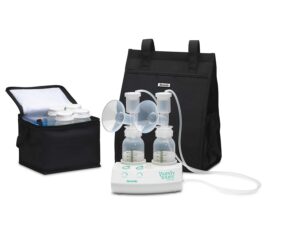

If you’ve read our double electric breast pump reviews you’ll probably already know the answer to this one.
But if you haven’t we’ll give you a quick rundown of both the Medela Pump In Style vs Ameda Purely Yours breast pumps and how they stack up against each other in each category.
Settings: Medela vs Ameda
Both the Ameda Purely Yours and the Medela Pump In Style come with settings for both suction and speed on very intuitive and easy-to-use control panels.
The thing that sets them apart is that the Medela Pump In Style also comes with a let-down phase that helps you achieve a natural flow by using a slower, deeper, suckling motion that mimics your baby.
While it’s not a necessity, we think it’s a great addition, especially for mothers who are just getting used to expressing milk.
Winner: The Medela Pump In Style Advanced
Ease of Use: Medela vs Ameda
Both pumps are very comfortable featuring high-quality breast shields that fit snugly and comfortably over the breasts.
The control panels on both units are very easy to use and both pumps are easy to operate while multitasking or nursing bub.
Winner: Draw
Cleaning: Medela vs Ameda
They both disassemble quite easily and are relatively easy to clean.
The Ameda Purely Yours, however, is slightly easier when it comes to cleaning as it employs a closed system.
This means the tubing leading into the motor doesn’t need to be washed. Also, some of the parts are even dishwasher safe, which is extremely convenient when you’re short on time.
Winner: The Ameda Purely Yours
Quality: Medela vs Ameda
Both pumps are exceptionally well built with durable motors and high-quality parts. The Medela, however, stands up to repeated and prolonged use better than any other pump on the market.
If you spend some time reading the real user reviews over at Amazon you’ll find it very rare that the Medela suffers from any reduction in suction or operation over long periods of time.
The Ameda Purely Yours also rates very highly in this category but not quite as well as the Medela.
Winner: The Medela Pump In Style Advanced
Verdict on the Comparison
While the Medela Pump In Style wins this battle, it should be noted that the Ameda Purely Yours is generally on sale at a cheaper price so it really comes down to a choice of quality over cost.
If you can afford it, the Medela Pump In Style can’t be beaten. If you can’t, then the Ameda Purely Yours is a very good second choice.

